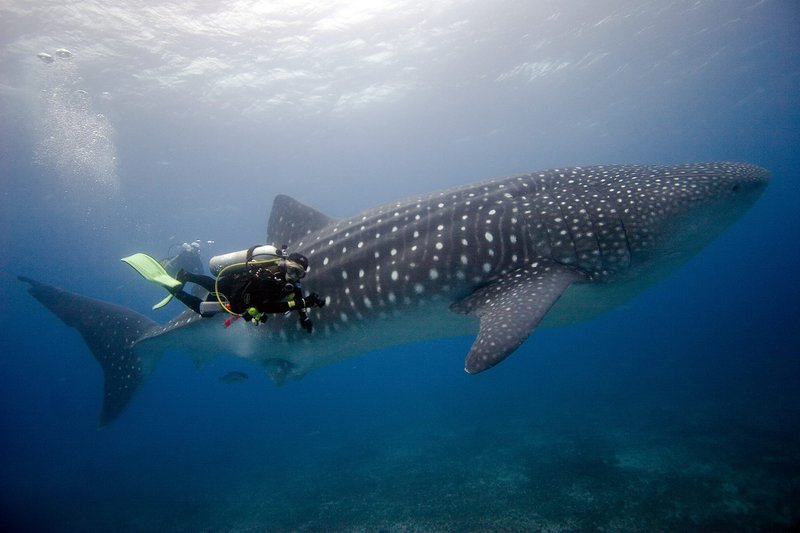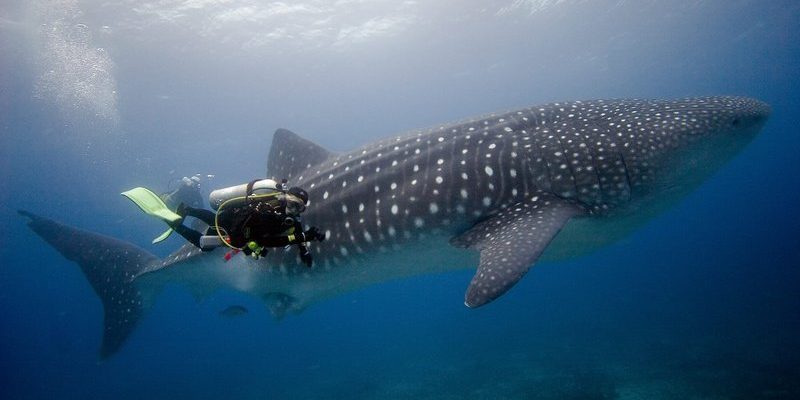
Here’s the thing: despite their size, they’re not dangerous. In fact, they feed mostly on tiny plankton! Learning about these magnificent creatures is like peeling back the layers of a captivating story. So, let’s dive into some fascinating facts about whale sharks that will leave you in awe of these gentle ocean dwellers.
1. The Biggest Fish in the Sea
Whale sharks can grow up to an astonishing length of 40 feet (12 meters) or even longer in some cases. To put this into perspective, that’s about the length of a school bus! The largest recorded whale shark was around 61 feet (18.8 meters). They can weigh up to 20 tons, making them the heavyweight champions of the ocean.
These massive creatures belong to the Rhincodon typus species and are known for their distinct mottled skin. Each whale shark has a unique pattern, much like human fingerprints. This uniqueness helps researchers identify individual sharks and track their movements over time. When you see a whale shark swimming, it’s like encountering a gentle giant that has seen the ocean’s secrets for generations.
2. Plankton Feasters
You might be surprised to learn that whale sharks are filter feeders. Yes, these huge fish primarily eat plankton, small fish, and the occasional shrimp. They use a technique called filter feeding, where they swim with their mouths wide open and take in vast amounts of water. Their gills then filter out the food, allowing them to consume thousands of pounds of plankton each day.
So, how does that work? As they swim, whale sharks gulp in water, using their specialized gills to trap tiny organisms. It’s like having a built-in strainer! This feeding method allows them to thrive in various marine environments. So, when you see one swimming gracefully through the water, imagine it munching on delicious tiny morsels.
3. They’re Gentle Giants
Despite their intimidating size, whale sharks are known for their docile nature. They are not aggressive and are often curious about divers and snorkelers. Many people describe their encounters with these animals as magical and unforgettable.
You might even find whale sharks swimming along the surface of the water, allowing for incredible close-up experiences. It’s like meeting a gentle giant that just wants to glide along with you in its underwater world. It’s crucial, however, to approach them respectfully and maintain a safe distance to avoid disturbing their natural behavior.
4. Wide-ranging Travelers
Whale sharks are true nomads of the sea. They can travel long distances, often migrating thousands of miles between feeding and breeding grounds. Their migratory patterns are influenced by water temperature and food availability.
For instance, some populations are known to gather annually in certain regions, like the waters off the coast of Mexico and the Philippines, during specific seasons. They often gather in nutrient-rich waters where food is abundant. This behavior makes observing whale sharks a seasonal delight for marine enthusiasts and researchers alike.
5. Vulnerable Species
Unfortunately, whale sharks are classified as a vulnerable species. They face threats from overfishing, bycatch, and habitat loss. Despite their size, they are not immune to the dangers that humans pose. Bycatch—when non-target species are caught unintentionally—can significantly impact their populations.
Here’s the thing: protecting whale sharks is essential not only for their survival but also for the health of marine ecosystems. Efforts are underway worldwide to establish marine protected areas and promote responsible tourism to ensure that future generations can enjoy these gentle giants.
6. Reproduction Mysteries
The reproductive habits of whale sharks remain one of their biggest mysteries. They are ovoviviparous, meaning that the female gives birth to live young, but the specifics of their reproduction are still largely unknown. Some researchers believe that female whale sharks can have up to 300 pups at a time!
Imagine a tiny whale shark pup, just a few feet long, entering the world in the vast ocean. These little ones, however, face various challenges. Not much is known about their growth and development, which makes studying them all the more exciting and important for conservation efforts.
7. Unique Patterns and Colors
One of the most striking features of whale sharks is their unique skin patterns. The dark blue-gray bodies are dotted with white spots and stripes, creating a stunning visual display. These patterns not only make them beautiful but also serve a purpose.
The spots help in camouflage, making it harder for predators to spot them in the dappled light of the ocean’s depths. This natural design is truly a work of art! Researchers can even use these patterns to identify and track individual whale sharks, adding to the wonder of studying them.
8. Cultural Significance
In many cultures, whale sharks hold a significant cultural value. They are often seen as symbols of peace and wisdom in coastal communities. Local legends and stories often celebrate their gentle nature and large size.
Whale shark tourism has also grown over the years, allowing people to interact with these creatures responsibly. Businesses focused on ecotourism provide educational opportunities for visitors and promote conservation efforts. It’s a way for communities to appreciate and protect these magnificent animals while sharing their beauty with the world.
9. Health Indicators of Marine Ecosystems
Whale sharks are often considered indicators of ocean health. Their presence in a particular area can signal that the marine ecosystem is thriving. Conversely, a decline in their population can highlight environmental issues.
Monitoring whale shark populations helps scientists understand broader trends in marine health. By studying their movements and behavior, researchers gain insights into the health of oceans and can implement conservation strategies accordingly. Keeping an eye on these gentle giants helps protect numerous other marine species, too.
10. Amazing Conservation Efforts
Many organizations and governments are dedicated to protecting whale sharks. Various initiatives focus on raising awareness, implementing fishing regulations, and creating marine protected areas.
For instance, countries like the Philippines and Mexico have established specific seasons for whale shark tourism, promoting responsible practices among tourists and fishermen. Education plays a crucial role in conservation—understanding the importance of preserving these gentle giants can inspire collective action to protect them.
Whale sharks are truly remarkable creatures that deserve our respect and protection. By learning more about them, we can better understand our role in safeguarding the oceans.
In conclusion, the fascinating world of whale sharks is filled with mysteries and beauty. From their gentle feeding habits to their long migrations, these creatures are a reminder of the wonders of the ocean. By appreciating and protecting them, we can ensure that future generations will also get to know these gentle giants of the sea.

